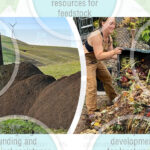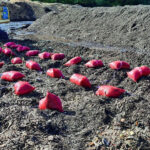 Sally Brown
Sally Brown
Regenerative agriculture is right near the top of the Drawdown list, with the potential to sequester 14.5 to 22.25 gigatons of carbon dioxide (CO2). Storing carbon saves money — $2.3 to 3.5 trillion lifetime net operational savings. Regenerative agriculture does not refer to spa weekends for farmers. It means restoring soil health. According to Drawdown the key to soil health is feeding the soil. According to every soil scientist who has a brain it means increasing soil carbon.
The Drawdown document says that the way to do this is:
- No till
- Diverse cover crops
- In-farm fertility
- No pesticides or synthetic fertilizers
- Multiple crop rotations
They also say that compost application, green manure and growing organic are good bonus practices but don’t include them on the main list. To understand how these practices might work, you first have to understand why carbon (soil organic matter or SOM) is the key to soil health.
Role of Carbon In Soils
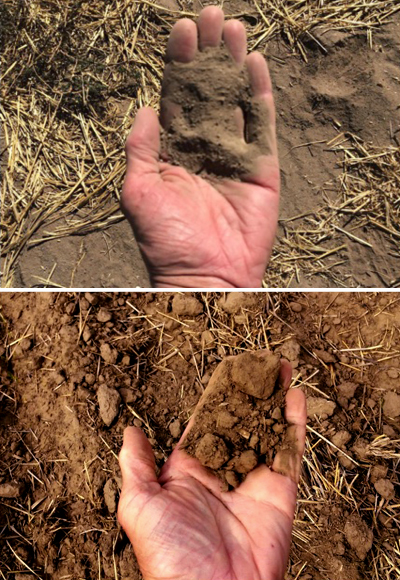
Visual difference between soils lacking organics material (top) and soil featuring organic material (bottom).
A good starting point is to realize what part of soil actually has an appetite. When you consider soil as the “living skin of the Earth” (my favorite way to describe it), you realize that like all other living things, soils get hungry. Soil consists of three fractions: mineral, organic and pore space. None of those actually require food. The wide range of organisms that live in the soil require the food. In addition to food, most also rely on soils to provide air and water.
These creatures go from microscopic to more than macroscopic and are the ones that keep soil functioning. These are the critters that break down organic matter (eat) and release excess nutrients into the soil for the plants to take up. They are also the good guys that fight off the bad guys. That is another way of saying that beneficial soil microbes will outcompete any disease-causing organisms, thereby suppressing soil borne diseases associated with microbial agents. In other words, you have enough food, and you have enough good guys doing their jobs, then you don’t need pesticides or synthetic fertilizers.
In addition to feeding these soil microbes, carbon gives them air to breath and water to drink. Organic matter in soils is a source of food for soil organisms but it is also critical to soil structure. If you go way back to a January column, “Compost + Rainwater Infiltration,” I talk about this at length. Soils higher in organic matter have lower bulk density. That means more pore space, thus more room for air and water. This is discussed in my two-part column on irrigation efficiency (see “Why Compost Is Cheapest Irrigation System” and “Irrigation + Compost Math”) because water will soak into soils faster and have a place to hang out once it has made its way inside.
On a fundamental level, the way to increase soil carbon is to fix more carbon from the atmosphere. Photosynthesis is the key process involved. I talked a lot about this in the Decay in Place part of this series. The Drawdown solutions get to this in different ways. The basic premise of no-till is that it slows the rate of carbon mineralization (microbes using the carbon for food) by limiting oxygen flow into the soils. If the microbes can’t breathe, they won’t be able to eat (mineralize) the carbon. Cover crops can be effective because they take advantage of a soil’s ability to grow its own carbon when it isn’t being used to grow our food.
Both of these are in-place solutions. How quickly these solutions can work will depend on how degraded a soil is to start with. If you are asking a highly degraded soil to grow its own carbon to help it feel better, you are talking about a lengthy process. Think of going from the equivalent of couch potato to a respectable 10 km race and not ending up in the ER. Also imagine doing this on a time frame expressed in growing seasons not days.
Proposed Solutions
All of the practices that Drawdown recommends are good things. But they don’t all build soil carbon. In-farm fertility, where all of the nutrients used on the soils come from sources within the farm (e.g., green manures and use of animal manures from on farm animals), is a great concept and is a lovely code to live by. But it only builds soil carbon via a very indirect pathway and highly complicated set of assumptions. One of the critical problems is that it is hard to build in-farm fertility when the vast majority of what you grow and its associated waste is shipped off site. Any changes there would be nearly impossible to measure. If you are talking about building soil carbon like you talk about building a house, in-farm fertility is the equivalent of picking out the tiles for the bathroom. It is a finishing touch that has nothing to do with the integrity of the structure.
Even the two practices on the list that are the ringers — no till and diverse cover crops — vary widely in their reported efficiencies. A meta-analysis of studies (Powlson, 2014) on no till found that while the top 15 cm (6”) of soil got healthier with no-till, the bottom part of the soil profile actually lost carbon resulting in no net sequestration. Another meta-analysis of cover cropping (Poplau et al, 2015) found that using cover crops stored about 0.3 ± 0.01 tons of carbon per year. After 155 years, soils would be back to steady state with a mean total carbon addition of 16.7 ± 1.5 tons of SOM per hectare. I’m not saying that you shouldn’t embrace these things. I would just argue that if you are looking for a return to sustainable soils in the near term, we need something faster and better.
How About We Start By Closing The Loop
Drawdown does mention compost but it seems almost like an afterthought. How about we take compost and other waste derived organics and put them on the list front and center? If you had the incentives and made the effort you could take that excess fixed carbon that started out on the farm but has ended up in garbage cans, waste dumps, landfills, and manure lagoons and put it back on the soil. Just like back in the good old days.
This is the step that Drawdown and anyone associated with agricultural policy should be focused on. Talk about fast and easy. This is not only a guilt free solution, it is a “you should feel guilty if you don’t’ solution.” Let’s put this in some perspective. We can start with the rate of soil carbon accumulation. The same guy (Powlson) who wrote that paper on no-till (no net C accumulation) also wrote one on returning wastes to soil (Powlson, 2012). He got his data from previous papers and the work focused on soils in England and Wales.
Powlson et al compiled studies that had looked at soil carbon accumulation in fields where these “wastes” had been used over time. These wastes included farm yard manure from cattle, dairy slurry, digested biosolids and green compost. Remember, California, the state we have been focusing on throughout my Drawdown series, has lots and lots of dairy cows and plenty of biosolids and composts. The researchers looked at application rates per hectare and modeled carbon saved from both avoided use of fertilizer and soil carbon accumulation. Here is what they found:
Green Compost (65% solids, 13% carbon, applied at 36 m3 ha-1)
CO2e for Fertilizer 55 kg ha yr-1
CO2e for Soil Carbon 5130 kg ha yr-1
Dairy Slurry (6% solids, 32% carbon, applied at 83 m3 ha-1)
CO2e for Fertilizer 305 kg ha yr-1
CO2e for Soil Carbon 1100 kg ha yr-1
Farmyard Manure (25% solids, 32% carbon, applied at 42 m3 ha-1)
CO2e for Fertilizer 180 kg ha yr-1
CO2e for Soil Carbon 2310 kg ha yr-1
Municipal Biosolids (25% solids, 35% carbon, applied at 33 m3 ha-1)
CO2e for Fertilizer 125 kg ha yr-1
CO2e for Soil Carbon 5500 kg ha yr-1
If you compare these to the actions listed in Drawdown where there is documentation in the literature on associated soil carbon increase, it is pretty clear that organics knock them out of the park. Remember that no till gets you healthier surface soil but no net carbon increase with depth. Cover crops give you 0.3 tons of carbon per hectare each year. Table 1 expresses the increases from organics to those from cover crops.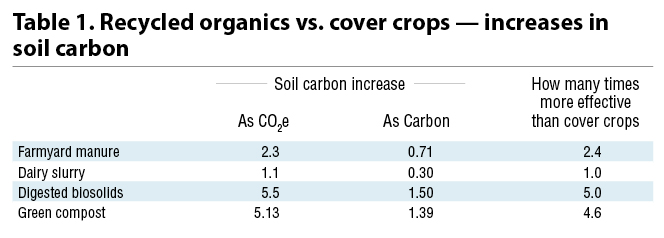 So here you have recycled organics that are 1 to 5 times more effective than cover crops. To me this goes on the top of the list. If you want to look at it from a California specific perspective, we can talk about it in terms of a study from UC Davis (Tautges et al) that recently made the headlines. Scientists looked at the role of cover crops and cover crops + compost in soil carbon to a depth of 2 m. While the cover crops increased soil carbon in the top 30 cm (1.44 tons of carbon per hectare), if you considered the whole depth, you end up literally in the hole: a net decrease in carbon (13.4 tons less carbon across the whole profile). If you look at the combination of cover crops and compost you get a net increase of 21.8 tons of carbon per hectare across the 2 m depth. We need to stop thinking of this stuff as garbage.
So here you have recycled organics that are 1 to 5 times more effective than cover crops. To me this goes on the top of the list. If you want to look at it from a California specific perspective, we can talk about it in terms of a study from UC Davis (Tautges et al) that recently made the headlines. Scientists looked at the role of cover crops and cover crops + compost in soil carbon to a depth of 2 m. While the cover crops increased soil carbon in the top 30 cm (1.44 tons of carbon per hectare), if you considered the whole depth, you end up literally in the hole: a net decrease in carbon (13.4 tons less carbon across the whole profile). If you look at the combination of cover crops and compost you get a net increase of 21.8 tons of carbon per hectare across the 2 m depth. We need to stop thinking of this stuff as garbage.
 Some of our municipalities get it. Just take a look at the for King County (WA) biosolids website for Loop®, “Turn Your Dirt Around.” DC Water had its own version for Bloom®, its Class A Exceptional Quality biosolids product.
Some of our municipalities get it. Just take a look at the for King County (WA) biosolids website for Loop®, “Turn Your Dirt Around.” DC Water had its own version for Bloom®, its Class A Exceptional Quality biosolids product.
The importance of recycled organics in regenerative agriculture needs to be understood, not only by the municipalities that manage the feedstocks, but also by organizations like Drawdown, carbon crediting groups and most importantly, state and federal agencies. The impact of organics for regenerative agriculture ties together most of the stuff I’ve been talking about in this Drawdown series:
- You make the soil better through regenerative agriculture.
- With better soil you use less water (irrigation efficiency).
- With healthier soil you need less fertilizer (too much food).
- With better soil you grow bigger crops whether those crops are trees (forestry) or pineapples.
Composts and other recycled organics are the best tools we have to do this. We have the wheel, no reinvention necessary. Let’s start rolling with it and stop wasting time ignoring the obvious.
Sally Brown, BioCycle’s Senior Adviser and long-time Connections columnist, is a Research Professor in the College of the Environment at the University of Washington.



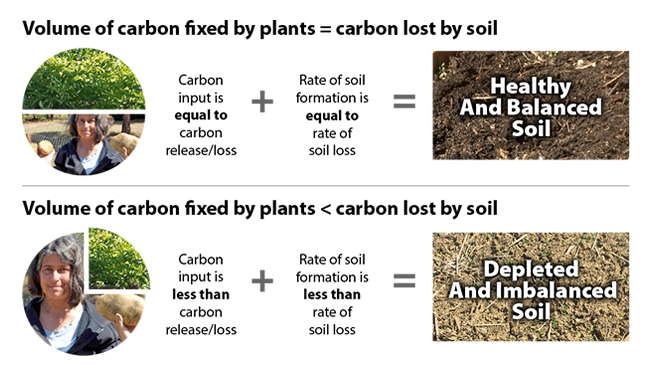 Soils become unhealthy and out of equilibrium when the ratio of inputs to outputs is not equal (bottom “equation” in figure). Here I’m taking the potatoes away from the soil but not feeding the soil in return. The outputs (potatoes) exceed the inputs (no organics added to the soil). Over time this will reduce the productivity and health of the soil.
Soils become unhealthy and out of equilibrium when the ratio of inputs to outputs is not equal (bottom “equation” in figure). Here I’m taking the potatoes away from the soil but not feeding the soil in return. The outputs (potatoes) exceed the inputs (no organics added to the soil). Over time this will reduce the productivity and health of the soil.